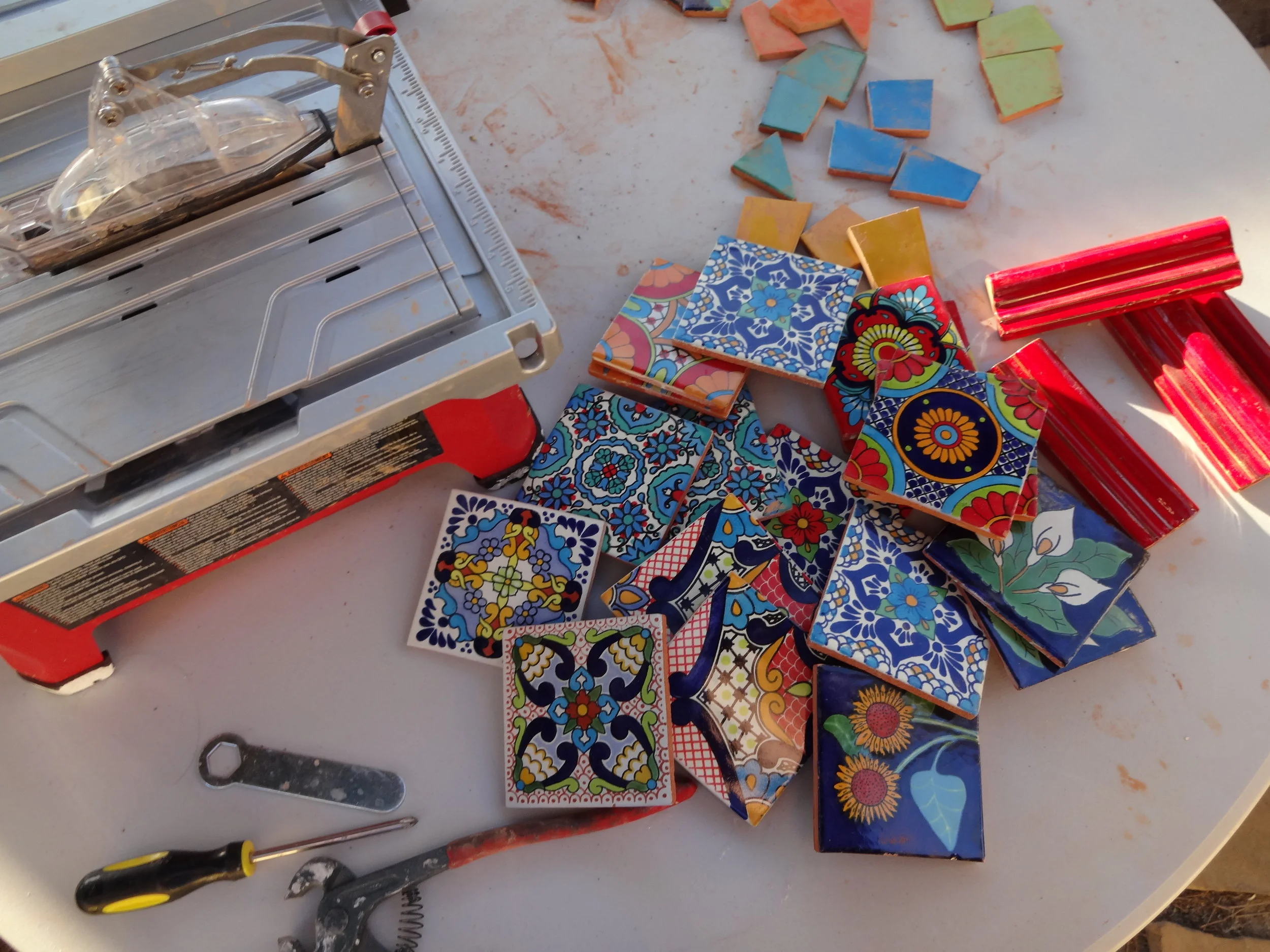
Materials and Process
SMALTI
Smalti refers to an opaque glass tile produced by pouring the molten glass into flat round slabs (called “pizzas” in Italy, and “tortillas” in Mexico), which are then chiseled into small bricks that can be cut and shaped further. Smalti originated in the Byzantine empire (4th-15th century) and can be seen in the stunning mosaics created during that time. The colors are deep and saturated and can be quite reflective. The inherent irregularity of smalti can create a highly textured mosaic. Smalti comes in a wide variety of hues, as well as iridescent and metallic. The Octopus and Anesthesia surfboards, and Frida Kahlo portrait featured in the Gallery section of this website utilize both opaque and iridescent smalti.
STAINED GLASS
Stained glass as we know it today goes back as early as the 7th century, utilized in the leaded glass windows of churches and monasteries of Western Europe. The variety of stained glass colors, patterns and textures available today is extensive.
FUSED GLASS
Glass fusing is the melting together of specific types of glass in a kiln to form a new, more interesting and complex piece. Sheets of glass are layered to form different textures, patterns, colors, and effects. Using frit (crushed or powdered glass), 24-carat gold paint, and different firing temperatures and times produce a wide variety of properties.
MILLEFIORI
Produced in Venice, Italy, the term “Millefiori” means “a thousand flowers”. The art form may go back as far as ancient Rome, but the modern resurgence came about in the 19th century. Millefiori begins as long glass rods, or “canes”, containing multicolored patterns that run the length of the rod and are only visible from the cut ends. These canes are then sliced into discs. Millefiori comes in a multitude of colors, patterns, and sizes.
TALAVERA
Talavera pottery is the Mexican variation of the Spanish majolica earthenware, a white and glazed type of ceramic. Although the Spaniards introduced this type of pottery, the term Talavera is used much more in Mexico than in Talavera de la Reina, Spain. In fact, Talavera is the oldest tin-glazed ceramic in the Americas and it is still being manufactured with the same techniques as in the 16th century.
DIRECT METHOD
This involves adhering the tesserae directly to the substrate. Once adhered, they are difficult to remove, manipulate and rearrange. The Octopus, Reef, and Ocean Meditation surfboards were created with this technique.
INDIRECT METHOD, OR REVERSE TECHNIQUE
In this technique, the tesserae are arranged face-down on a sticky substrate such as mesh, contact paper or tape. The artist’s view throughout this step is of the back side of the mosaic- the side that will be adhered to the final substrate. Once completed, the mosaic is transferred to the final substrate with permanent adhesive, and the water-soluble adhesive dissolved and removed. This has the advantage of providing a smooth surface to the finished mosaic. Although this allows for easy re-manipulation of the tesserae during the process, one cannot see the actual “face” of the mosaic until it is permanently set, which can be challenging. The Anesthesia surfboard utilized this technique.
DOUBLE INDIRECT, OR RAVENNA METHOD
This technique replicates that of the original Byzantine artists, and is still practiced in Ravenna, Italy. The tesserae are arranged on a temporary sticky substrate (tape or a bed of slaked lime), but this time, face-up. This allows not only re-manipulation of the tesserae, but permits the artist to see the mosaic precisely as it will look when permanently adhered to the final substrate. Once the mosaic looks exactly as the artist envisions it, a fine cloth (such as cheesecloth) is laid on top. This cloth is then adhered to the face of the mosaic with water soluble glue (traditionally, rabbit skin glue). Once fully dried, the mosaic can be lifted and applied to the final substrate. Once fully set, the glue is dissolved and the cloth carefully removed. The face, bust, and arm/hand of the Frida portrait were created with this technique.




![20190205_124736-1[17733].jpg](https://images.squarespace-cdn.com/content/v1/55cd5032e4b06c2348a1f1ab/1611115943658-E8MJNW1KOEJ7VCLFECC4/20190205_124736-1%5B17733%5D.jpg)



